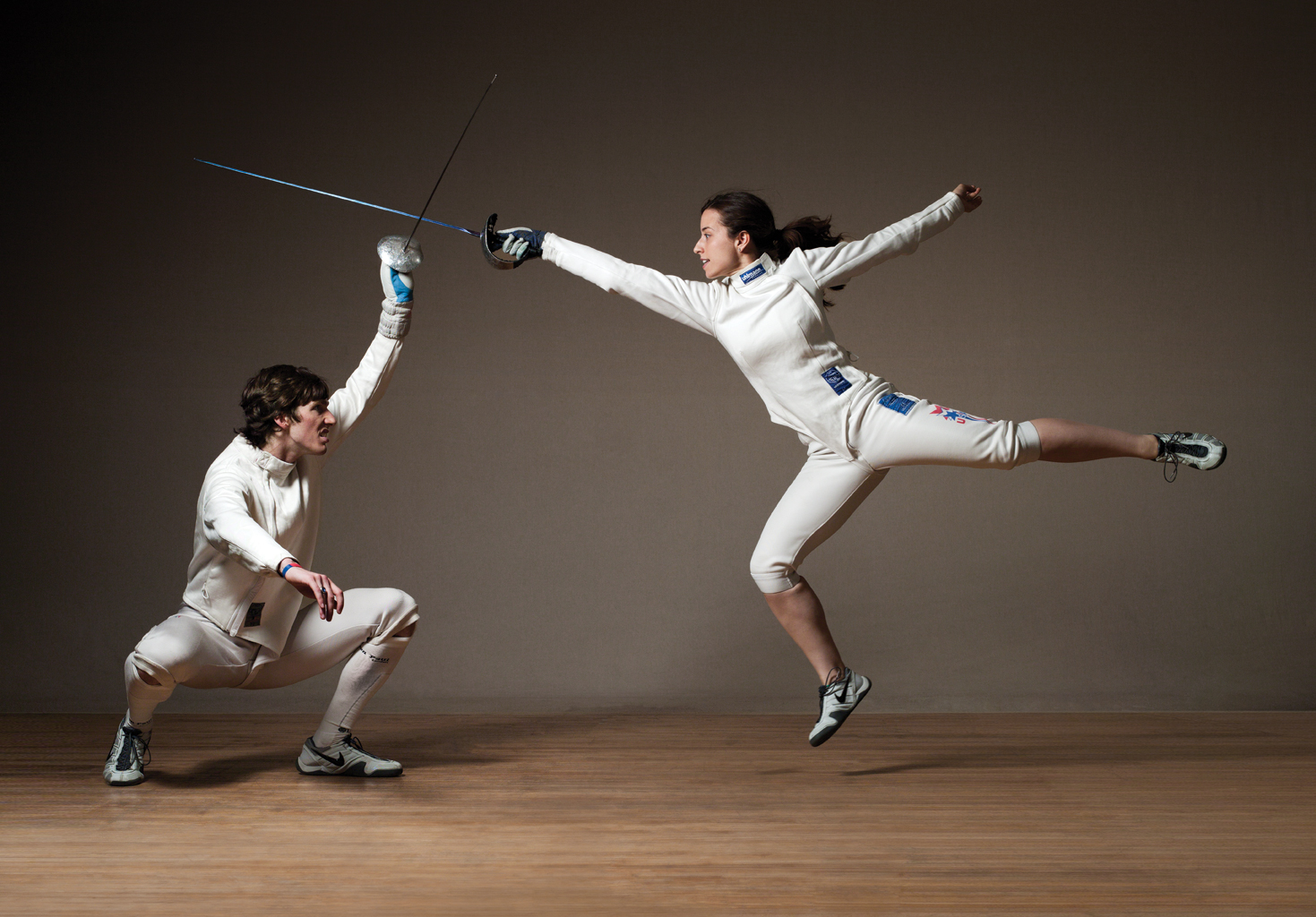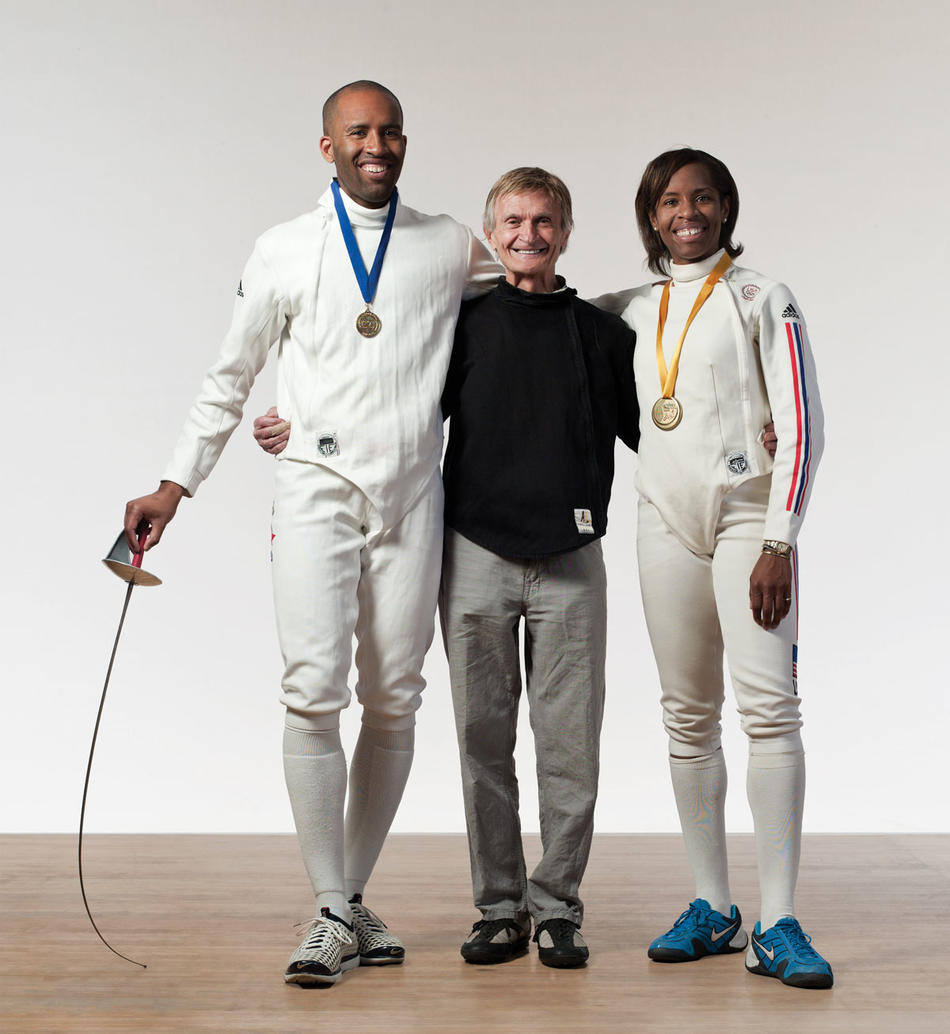
Halte!
At the referee’s command, our fencer lowers her weapon and steps off the fencing strip. She just blew the winning point. Now it’s 14–14. What if she loses? What will it mean for her ranking? Her Olympic hopes? Oh, and her paper on Milton — was that due this week or next?
She has 15 seconds to eliminate these thoughts — all thoughts — and enter what her coach, Dr. Aladar Kogler, calls the flow state, that place of full integration of mind and body, what athletes and performers call the zone, what artists and scientists call inspiration, what believers call ecstasy. She draws a breath and exhales...the negative thoughts go out...she reminds herself of past triumphs, of her coach’s emphasis on playfulness and enjoyment, his belief that improvement is more critical than victory. Some coaches prowl the sideline, yelling, “Wake up!” Not Kogler. He radiates calm and confidence. Earlier, during a break, he had gone over to our rattled fencer and silently patted her shoulder.
Later, she will have to write a detailed report of her bout. What was she feeling? What went wrong or right? What was her state of mind? Coach Kogler wants to know.
She will see him soon, at her next lesson. There, underground in Dodge Fitness Center, she will encounter him — the nimble, sprightly, ageless Aladar, so light on his feet that he seems to glide. With his sinewy frame and hollowed cheeks, one might take him for a ballet master, or the patriarch of a family of aerialists. At lessons he wears burgundy velour sweatpants and a black protective jacket. He’ll meet our fencer on the strip and commence the day’s drills. Repetition, so that the body remembers what the mind must abandon. Technique must be automatic. If you think, you are not in the moment. A squeak of sneakers, the tap and clink of clashing metal, melodies in the invisible phrases scribbled on air by the dancing blade-points, but our fencer, focused, will hear nothing as she thrusts her weapon at Aladar’s heart.
Like many fencers, she came to Columbia for Maestro Kogler. She was from Ohio, Massachusetts, Brooklyn, Texas, California, upstate New York. She had met him at a fencing camp, at a tournament, had transferred from another school to train with him. He had noticed her, too, had seen weaknesses that he could turn into strengths, strengths that he could turn into coups de grâce on a world stage. He would open her channels. Technique wasn’t enough. They called it physical chess for a reason: Here were tactics and penetration on a mortal level. (“Physical speed chess” in the words of 2008 NCAA men’s sabre champ Jeff Spear ’10CC.) And here was Kogler, fencing Hall of Famer, courtly citizen of eight Olympic villages, who understood the sport better than anyone. Most fencing coaches were specialists, but Kogler, driven to extremes in his youth, was master of all three weapons — foil, sabre, and épée, each with its own rules and techniques. I had to be the best, he often said, and he meant it.
Our young fencer had heard the stories. How Kogler was born in 1933 to an upper-class family in Hungary, where fencing, a modification of dueling created to stem the blood-tide of many a gored nobleman, had reached its highest development. It was the Kogler family sport. But after World War II, the northern part of Hungary was annexed by communist Czechoslovakia, and the Koglers, marked as bourgeois capitalist aristocrats, were yanked from their home at gunpoint at 2 a.m. and sent into exile.
No plumbing, no electricity, no work permit. Kogler’s father had a heart attack and died. His mother suffered paralysis in her face. His older brother escaped to the West and was labeled a spy. Aladar, 13, broken and miserable, fled to Hungary as a refugee to attend school. He had thoughts of suicide. To heal himself he explored a foreign philosophy that was introduced to Hungary in 1936 by Selvarajan Yesudian of India. Yoga, it was called, and Kogler sought out every book on it he could find. But in 1947, Hungary turned communist, and yoga, with its Hindu-spiritual currents, was banned. Aladar was sent back to what was now Slovakia. As a class enemy, he was expelled from school, and so he decided to earn his working-class credentials — and any hope for an education — by volunteering in the most dangerous coal mine in Moravia. This furthered his project of self-discipline. Control the thought and you control the emotion. Aladar, soot-streaked, was allowed to finish his studies privately, and was admitted to the Institute of Physical Education and Sport in Prague as a gymnast and diver.
Then the Soviets figured it out. During the Cold War, Olympic medals were a means to demonstrate the superiority of one’s political system, and fencing, that emblem of the aristocracy, provided a chance to win many medals. Three weapons, men and women, individual and team, and with all those skilled Hungarians — one can imagine the excitement in the Central Sports Committee. Kogler, a highly accomplished fencer, had been obliged until then to keep his powers a secret. Now, under a regime that poured science and rubles into its athletes, his ability became his passport.
But, alas, as Kogler prepared to compete in East Germany, the KGB discovered his family connections — his brother a spy — and he was barred from international competition. Imagine: a potential world champion who cannot compete. The injustice did not shake him. He had learned to control his emotions. He would, he was told, be allowed to coach, and it was then that he made his decision. If I cannot be the best athlete, I want to be the best coach in the world.
Kogler was appointed head coach of the Czechoslovakian national team, and trained 39 national champions in Austria and Czechoslovakia. He got his PhD in sports psychology from Charles University in Prague. If I put everything into sport, I will survive. His success brought him certain privileges, as he had hoped it would. After the 1980 Summer Olympics in Moscow, Kogler, back in Slovakia, was permitted to travel 60 kilometers across the border to Vienna to coach the Austrian team, an arrangement that brought valuable Western currency to the Czechs.
In 1981, Kogler and his wife and son defected to Austria. They were placed in a refugee camp. Kogler’s goal was to get to America, where a job awaited him once he got his papers. Then, on a summer day, Kogler was paid a visit by the Austrian secret police, who informed him that the Czechs were plotting to steal him back. The Koglers were put in a car and driven from the camp to a village in the Alps. Ten days later, Kogler was in Detroit.
Freedom! Kogler was now the fencing coach at Wayne State University, replacing his old friend, the Hungarian master Istvan Danosi.
After winning the men’s NCAA crown at Wayne State, Kogler joined Columbia in 1983 as head coach of the women’s team. That same year, he was named men’s and women’s head coach for the U.S. national team. At Columbia, Kogler and men’s head coach George Kolombatovich formed a partnership as co–head coaches that would last 28 years. Kolombatovich’s chief focus was recruitment and administration, while Kogler was the man on the strip, behind the mask, the first PhD in sports psychology to coach in the United States, the European Zen-Meister with his visualization and biofeedback and relaxation techniques, his mantras, his writing assignments, his pressure drills for big national events. Under Kogler’s sword, Columbia women and men won 25 Ivy League championships and five NCAA team titles, and produced 13 NCAA champions and 14 individual Division I national champions, in all weapons.
En garde!
Our fencer lowers her mask and faces her opponent, her weapon aimed as if at the North Star in a smooth line from her forearm. Kogler has trained her well. He embodies his teaching, he knows adversity, and so perhaps she wasn’t surprised, after hearing the news this spring that her 78-year-old coach was retiring from Columbia, that Kogler had parried any final touch. The maestro will continue to train top fencers for the 2012 and 2016 Olympics, and to pursue, with international cooperation, his scientific research into psychological preparation and the identification of athletic talent.
Kogler’s transition was the occasion of an ingathering this summer in photographer Lois Greenfield’s studio for Columbia Magazine. There, a few of Kogler’s standouts, past and present, spoke joyfully of their guru. They called him disciplined, meticulous, intense, amazing, good-hearted, good-natured, the best coach ever, someone you wanted to emulate. “The most invaluable thing he taught me was to face my fears,” said Keeth Smart ’10BUS, team silver medalist at the 2008 Olympics. Columbia University Athletics Hall of Famer Caitlin Bilodeau ’87CC, a two-time Olympian and four-time national champion who, like Kogler, is also enshrined in the United States Fencing Association Hall of Fame, said, “His direction, his personality, his way of engaging you — the whole aura of who he is — inspires you to want to be the best, and to believe you can be.”
Prêt!
Our fencer is ready. Her blade catches the light as the spectators lean forward in their chairs. But she is not in this world. She is inside a moment. She knows that she must take the game, take everything, as Kogler says, one touch at a time. It’s 14–14, but for our fencer, the score is always 0–0.





